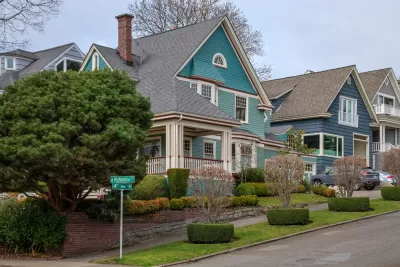Form-based zoning codes can encourage mixed-use development and walkable neighborhoods, but focusing too much on aesthetic elements can drive up the cost of housing.

Writing in The Urbanist, Ryan DiRaimo explains form-based codes, which Seattle is exploring as part of the city’s effort to reform its zoning code.
According to DiRaimo, “The great thing about a form-based code is that it allows things like coffee shops, bookstores, corner stores, and small retail to mix in with the neighborhoods previously zoned exclusively for residential. With a form-based code’s flexibility for land-use, we can finally have vibrant, walkable neighborhoods again.”
However, DiRaimo warns, “where a form-based code fails is when it is used to mandate aesthetic details that have little impact on improving the quality of the public realm—the very purpose of form-based code’s existence.” Pointing to a recently passed state bill, DiRaimo writes that regulating design and aesthetics too much can be “overly prescriptive” and discourage creativity in design.
“With the clock running out on Seattle’s planning process, there is a deep concern that form-based code adoption will include prescriptive design regulations because it’s an established element of the code according to a consultant who has already completed a template.” For DiRaimo, “The eclectic mix of different styles of buildings is what makes Seattle neighborhoods interesting and desirable,” and reviewing every small aesthetic detail won’t improve affordability.
“We need fewer rules and better processes,” DiRaimo concludes. “And since housing is almost never a charity, the aesthetic rules will only kill building plans, limit housing supply, and segregate who can afford to move into the neighborhood.”
FULL STORY: Op-Ed: Off-Base Form-Based Codes Could Be Headed to Seattle

Alabama: Trump Terminates Settlements for Black Communities Harmed By Raw Sewage
Trump deemed the landmark civil rights agreement “illegal DEI and environmental justice policy.”

Planetizen Federal Action Tracker
A weekly monitor of how Trump’s orders and actions are impacting planners and planning in America.

How Atlanta Built 7,000 Housing Units in 3 Years
The city’s comprehensive, neighborhood-focused housing strategy focuses on identifying properties and land that can be repurposed for housing and encouraging development in underserved neighborhoods.

In Both Crashes and Crime, Public Transportation is Far Safer than Driving
Contrary to popular assumptions, public transportation has far lower crash and crime rates than automobile travel. For safer communities, improve and encourage transit travel.

Report: Zoning Reforms Should Complement Nashville’s Ambitious Transit Plan
Without reform, restrictive zoning codes will limit the impact of the city’s planned transit expansion and could exclude some of the residents who depend on transit the most.

Judge Orders Release of Frozen IRA, IIJA Funding
The decision is a victory for environmental groups who charged that freezing funds for critical infrastructure and disaster response programs caused “real and irreparable harm” to communities.
Urban Design for Planners 1: Software Tools
This six-course series explores essential urban design concepts using open source software and equips planners with the tools they need to participate fully in the urban design process.
Planning for Universal Design
Learn the tools for implementing Universal Design in planning regulations.
Jessamine County Fiscal Court
Caltrans
Institute for Housing and Urban Development Studies (IHS)
City of Grandview
Harvard GSD Executive Education
Toledo-Lucas County Plan Commissions
Salt Lake City
NYU Wagner Graduate School of Public Service





























